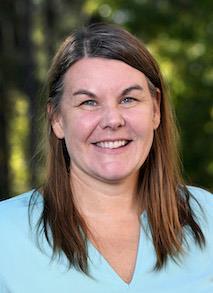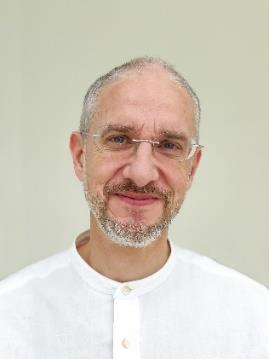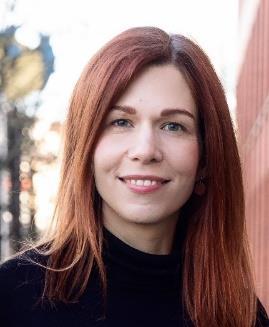MEET THE SPEAKERS
Workshop on critical innovations in pesticides safety testing and chemical risk assessment for developmental neurotoxicity (DNT)
28-30 October 2024

MEET THE SPEAKERS
Workshop on critical innovations in pesticides safety testing and chemical risk assessment for developmental neurotoxicity (DNT)
28-30 October 2024
Session
Lessons learned from existing IATA case studies using DNT-IVB data


Helena Hogberg PhD joined the NTP Interagency Center for the Evaluation of Alternative Toxicological Methods (NICEATM) within the Division of Translational Toxicology (DTT), National Institute of Environmental Health Sciences (NIEHS) in December 2021, where she is conducting research drawing on her broad expertise in applying in vitro methods to assessing developmental neurotoxicity (DNT) potential of chemicals. Previously she was the Deputy Director of the Center for Alternatives to Animal Testing (CAAT) within the Johns Hopkins University Bloomberg School for Public Health. She received her Ph.D. her in toxicology from Stockholm University but performed her research at the European Centre for the Validation of Alternative Methods (ECVAM) in Ispra, Italy. She serves on the expert groups for Thyroid Disruption and DNT of the Organisation for Economic Co-operation and Development (OECD); the Scientific Advisory Boards for the European Commission-funded Horizon 2020 grant, “Novel Testing Strategies for Endocrine Disruptors in the Context of Developmental NeuroToxicity (ENDpoiNTs)”, the Michael J Fox Foundation and the International Foundation for Ethical Research. She is also a member of the OECD Adverse Outcome Pathway Knowledge Base working groups and the Methods2AOP collaboration. Previously she served the U.S. Environmental Protection Agency (EPA) Scientific Advisory Panel for the Federal Insecticide, Fungicide, and Rodenticide Act; on new approach methodologies for DNT assessment.


Marcel Leist obtained an MSc in toxicology (Guildford 1989), and a PhD in pharmacology (Konstanz 1993). Since 2006, he has been head of the department of in vitro toxicology and biomedicine at the University of Konstanz (inaugurated by the Doerenkamp-Zbinden foundation), and director of the Center for Alternatives to Animal Testing in Europe (CAAT-Europe), a joint venture with Johns-Hopkins University. From 2000-2006, he worked as ‘Head of Department of Disease Biology’ on the discovery of neurology and psychiatry drugs in the Danish pharmaceutical company Lundbeck A/S. His research resulted in > 400 publications (cited over 40,000 times), and was awarded with many national and international research prizes. The current research addresses the question on how cell model data can be used for the prediction of the adverse effects of chemicals on the human population. The research focusses on new approaches to use alternative data sources. Steps towards this include (i) the development of non-animal new approach methods (NAM), (ii) the integration of multiple information layers from NAM in next generation risk assessment (NGRA), (iii) extrapolation of model data to complex real-life scenarios, and (iv) uncertainty analyses
for the predictions. An example is the contribution to the GIVIMP guideline issued by the OECD or the developmental neurotoxicity in vitro test battery promoted by the OECD and other organizations.


Dr Tim Shafer is a Research Toxicologist and Principal Investigator in the Biomolecular and Computational Toxicology Division in the Center for Computational Toxicology and Exposure in the Office of Research and Development at the U.S. Environmental Protection Agency. Tim earned his PhD from the Department of Pharmacology and Toxicology at Michigan State University.
For the past 15 years, Tim’s work has been directed towards development of new alternative methods for assessment of neurotoxicity and developmental neurotoxicity hazards of chemicals. He has published over 100 peer-reviewed journal articles, book chapters and reports; has received 8 Scientific and Technological Achievements Awards and Bronze and Gold medals for outstanding service to the Agency.
Dr Shafer has also served ORD as an Acting Branch Chief, Acting Assistant Laboratory Director for Human Health Research, Acting Director of the Integrated Systems Toxicology Division. In addition, he has held appointments and elected offices outside of EPA including serving on grant review panels (ALTOX3/NAL study section at NIH), Society of Toxicology Program Committee and Secretary/Treasurer of the Society of Toxicology’s Neurotoxicology Specialty Section, President of the International Neurotoxicology Association and appointments as Associate Editor for the journal NeuroToxicology and to the Editorial Board of Toxicology and Applied Pharmacology.


Dr. Iris Mangas is a Scientific Officer in the Mammalian Toxicology team of the Pesticide Peer Review Unit at the European Food Safety Authority since 2018. Currently, she coordinates EFSA programme for developing and implementing NAMs for testing and assessing pesticides neurotoxicity, including DNT, and manages several EFSA grants and procurements and Experts Groups. She is also in charge of conducting the peer review of pesticides active substances human health risk assessment in EU. Dr. Mangas is EFSA delegate in various OECD Expert Groups, including co-chair of the OECD Expert Group on the DNT IVB she also represents EFSA on IATAs, AOPs development and on NAMs validation guidance groups. Before joining EFSA, she was a regulatory toxicologist for public and private sector. Previously, Dr. Mangas was a researcher in molecular neurotoxicology in various universities and centres including Research Visitor in Molecular Toxicology Pharmacology in Skaggs School of Pharmacy and Pharmaceutical Sciences in the University of California San Diego. She is a Board-Certified Toxicologist (ERT), has a master’s degree in Environmental Toxicology from the University of Valencia; a MS degree in Epidemiology and Public Health by Miguel Hernandez University and a Ph.D. in Molecular Neurotoxicology by University Miguel Hernandez.


Haudek-Prinz


Dr. Agnes Karmaus is an expert in the integration of new approach methodologies (NAMs) in toxicology with over a dozen years of experience working with the Tox21 and ToxCast high-throughput screening programs. Her extensive experience with in vitro assay development, computational toxicology, and data annotation and integration, her current work seeks to integrate NAMs into actionable decision-making frameworks to support risk assessment in the agrochemical sector. Dr. Karmaus is passionate about bridging the gap between in vitro and in silico approaches in toxicology by facilitating the adoption of computational methods and helping provide context to render in vitro assay data more accessible and interpretable
PhD in Biology in the field of Cancer Research from the University of Vienna.
MScTox in Toxicology from the Medical University of Vienna.
Working since 2018 as a regulatory toxicologist at the Austrian Agency for Health and Food Safety (AGES) in the assessment of pesticides and plant protection products for human health.
Member of the OECD Expert Group on Biopesticides and European Commission’s Working Group on Biopesticides.


As a trained toxicologist with 20+ years of experience in regulatory toxicology and non-animal methods, I am leading the Regulatory Science Group at MUI. I act as Austrian national delegate for the OECD Expert Group on the DNT in vitro battery as well as for several other OECD working groups (WNT, VMG-Eco, ESCA, NGTxC-IATA) and for the European PARERE network. Furthermore, I work for the European Food Safety Authorities (EFSA) as a member of the PPR panel and other EFSA working groups related to Adverse Outcome Pathway (AOP) based Integrated Approaches to Testing and Assessment (IATA) of DNT. Working for the transformation to an animal free regulatory system through building bridges between science and regulation my group represents a regulatory-science partner within the European Research projects ALTERNATIVE, CHIASMA, INSIGHT and PARC. I am also leading the EFSA funded DNT-RAP4 project providing four new case studies for the use of the DNT in vitro test battery for the regulation of pesticides. Finally yet importantly, I am leading one proposal for the EPAA DESIGNATHON challenge for the development of a new, fully non-animal-methods based hazard classification system.


Sue Marty is a Senior Fellow and Toxicology Science Leader at the Dow Chemical Company in Midland, MI, USA. She has a doctoral degree in reproductive toxicology from the University of Michigan, Ann Arbor, MI, USA and conducted postdoctoral work in neurotoxicology at Michigan State University, East Lansing, MI, USA.
In her current role, Dr. Marty develops research strategies to evaluate and apply new approach methods (NAMs) for Dow’s Predictive Toxicology Program. In addition, she works with Dow R&D to deploy early screening approaches for more sustainable chemistries. She has served on numerous government-sponsored committees and currently serves on the OECD Developmental Neurotoxicity Expert Group and as an ad hoc member of the Scientific Advisory Committee on Alternative Toxicological Methods (SACATM). Previously, Dr. Marty conducted studies in Dow’s Toxicology Laboratory in developmental and reproductive toxicology (DART), endocrine disruption and neurotoxicology. She is a diplomate of the American Board of Toxicology (D.A.B.T.) and has ~100 peer-reviewed publications.


Jochem is a European Registered Toxicologist (ERT), who studied biology at Wageningen University and who obtained his PhD in Toxicology at the same university in a project in collaboration with Utrecht University and TNO preforming pioneering work on quantitative in vitro to in vivo extrapolation (QIVIVE). He worked as a postdoc at the European Reference Laboratory ECVAM of the JRC, after which he returned to Wageningen as assistant professor Toxicology, supervising various PhD students in projects on QIVIVE. He moved to the research institute Wageningen Food Safety Research (WFSR) focussing on the application of QIVIVE in food safety assessment and on quality aspects of in vitro input data in QIVIVE. Since February 2023 he works as a Scientific Officer Toxicology in the Mammalian Toxicology team of the Pesticide Peer Review Unit of the European Food Safety Authority.
Cecilia Tan, United States Environmental Protection Agency (US EPA), US


Dr. Cecilia Tan is a senior science advisor at the Health Effects Division at the US. Environmental Protection Agency’s Office of Pesticide Programs. Her main role is to review and apply pharmacokinetic data and models to improve the scientific basis for inter- and intra-species extrapolations in pesticide risk assessment. Before joining the Office of Pesticide Programs in 2018, Dr. Tan was a researcher at the EPA’s Office of Research & Development. Her research involved using computational modeling to understand the quantitative relationships between external exposure, internal doses, and adverse outcomes. She is actively involved in several physiologically based kinetic (PBK) modeling-related committees to facilitate more applications of PBK modeling in regulatory risk assessment. Dr. Tan has a MS degree in Environmental Health Sciences from the Harvard School of Public Health, a Ph.D. in Environmental Engineering and Sciences from the University of North Carolina, Chapel Hill, and a MBA from North Carolina State University.


Dr. Kathrin Bothe is a Regulatory Toxicology Expert at Bayer CropScience in Monheim, Germany, since 2017. She is responsible for the development of new agrochemical products and the regulatory defense of existing products covering the area of human safety. Her special focus is on regulatory implementation of New Approach Methodologies (NAMs) into a Next Generation Risk assessment.
She is a biochemist by training and before joining Bayer, she did her PhD and Postdoc at the Leibniz Research Institute for Environmental Medicine in Duesseldorf, Germany, in the group of Prof. Ellen Fritsche supporting the development of DNT in vitro assays that are now part of the OECD DNT in vitro battery. Moreover, she worked for two different consultancies as toxicology expert for industrial chemicals and cosmetics.
Kathrin Bothe is chairing the Croplife Europe DNT subgroup and is involved in different international activities around NAMs, including e.g. the EU RiskHunt3R project and OECD IATA case studies project.


Nynke Kramer is an associate professor in toxicology at Wageningen University and Research, where she teaches food toxicology, chemical safety assessment, and toxicokinetics. Her research focuses on developing techniques and models to improve the extrapolation of effect concentrations obtained from in vitro cell assays to toxic doses relevant to humans and animals. Before starting at Wageningen University in 2021, she was an assistant professor in toxicology at the Institute for Risk Assessment Sciences of Utrecht University, where she also obtained her Ph.D. in 2010. Nynke’s research has been awarded the SETAC Procter and Gamble Fellowship for Doctoral Research in Environmental Sciences. She used the prize money to do part of her research at the Swiss Federal Institute for Aquatic Science and Technology, Eawag, Dübendorf, Switzerland. Before starting her Ph.D., Nynke obtained her BSc degree in Life Sciences at University College Utrecht and her MSc degree in Environmental Change and Management at the University of Oxford.
Session 3: Tiered testing, Additional Assays and Non-Mammalian Animal Models– What do they have to offer to the DNT-IVB?
Katharina Koch, IUF – Leibniz Research Institute for Environmental Medicine, DNTOX, Germany


Katharina Koch leads the working group "Alternative method development for environmental toxicity testing" at the IUF - Leibniz Research Institute for Environmental Medicine in Duesseldorf, Germany. She received a B.S. degree in Biology and a M.Sc. degree in Molecular Biomedicine from the Rheinische Friedrich-Wilhelm University in Bonn. She received her Ph.D. degree from the HeinrichHeine University of Duesseldorf for her work on the development of novel therapies targeting chemo-resistant tumor stem cells in malignant brain tumors. Her current research focuses on the development of test methods for developmental neurotoxicity (DNT), endocrine disruption (ED)-mediated DNT and acute neurotoxicity. She has extensive expertise in the development and scientific validation of alternative in vitro test methods using primary fetal neural progenitor cells (NPCs) and induced pluripotent stem cell-derived iNPCs and the study of hormonal dependencies of neurodevelopmental key events. She is involved in several validation management groups of PEPPER, a French public private platform for the pre-validation of endocrine test methods. She is a member of the German Society of Toxicology (DGPT) and the Society of Toxicology (SOT). Furthermore, she is a co-founder of the company DNTOX offering DNT assay services and chemical testing for the chemical, cosmetic and pharmaceutical industry.
Megan Culbreth, Human Foods Program, U.S. Food and Drug Administration (FDA), US


Megan Culbreth, Ph.D. is a Supervisory Toxicologist and Predictive Toxicology Branch Chief in the Human Foods Program of the U.S. Food and Drug Administration. Dr. Culbreth is also the Developmental Neurotoxicology (DNT) Program Lead in the Division of Toxicology. As the DNT Program Lead, she oversees human-relevant in vitro DNT assay development. Dr. Culbreth has almost 20 years of experience in in vitro DNT. She is well-published in this field and has received numerous awards for her research. Dr. Culbreth is also an active member of the OECD Expert Group on the DNT in vitro battery and the Society of Toxicology Neurotoxicology Specialty Section.


Ellen Fritsche, MD, is the Director of the Swiss Centre for Applied Human Toxicology (SCAHT) in Basel, Switzerland. For the last >10 years she was a full University Professor at the Heinrich-HeineUniversity in Düsseldorf, Germany and working group leader of the group ‘Alternative method development for environmental toxicity testing’ at the IUF – Leibniz Research Institute for Environmental Medicine. She is a medical doctor by training and habilitated in environmental toxicology. She has more than 20 years of experience in toxicological sciences including mechanistic studies and more than 15 years of experience in the development of new approach methods in vitro. She coordinated the European Food Safety Authority (EFSA)-developmental neurotoxicity (DNT) project for application of a DNT in vitro battery for regulatory purposes. She participates in the European projects, ENDpoiNTs, ONTOX, PARC and CHIASMA. She is a member of the German MAK commission (Health Hazards of Chemical Compounds in the Work Area) and the DNT in vitro OECD Expert Group. She authored more than 90 publications in international peer-reviewed journals (h-index in Research Gate: 47), scientific opinions and book chapters. She is co-editor-in-chief of the journal Frontiers in Neurotoxicology. Recently, she founded the start-up company DNTOX – providing in vitro assay services for safety assessment.
Joshua Harrill, United States Environmental Protection Agency (US EPA), US


Dr. Harrill is a cellular and molecular toxicologist with the US Environmental Protection Agency's Center for Computational Toxicology and Exposure (CCTE). Dr. Harrill received his B.S. in Biochemistry from North Carolina State University and a Ph.D. in Toxicology from the University of North Carolina at Chapel Hill. Dr. Harrill’s expertise is in vitro toxicology, specifically the application of transcriptomics, high content imaging (HCI) and other complementary technologies for high-throughput chemical hazard screening, characterization, and risk assessment. Dr. Harrill is currently a lead investigator for CCTE’s high-throughput transcriptomics and phenotypic profiling chemical screening programs. These programs focus on the use of broad-based high-content profiling assays for bioactivity screening of environmental chemicals in human- and animal-derived in vitro test systems. One aspect of Dr. Harrill’s research has focused on the development of imaging-based high/medium-throughput assays for in vitro developmental neurotoxicity (DNT) screening including neuroprogenitor cell proliferation, neurite outgrowth, neurite maturation and synaptogenesis. More recently, Dr. Harrill has applied high-throughput profiling assays (transcriptomics and Cell Painting) for evaluating chemical bioactivity and toxicity in neural cell models. Dr. Harrill also has experience from the private sector in conducting human health risk assessments using USEPA and state-level guidance as well as devising and managing rapid-phase environmental sampling, analysis and data interpretation programs during events involving the release of potentially hazardous chemicals.


Dr. Smirnova is an assistant professor at the Environmental Health and Engineering Department at Bloomberg School of Public Health and Center of Alternatives to Animal Testing, Johns Hopkins University, where she is leading Education Program and Program on microphysiological systems. She has joint appointments at Johns Hopkins School of Engineering and Georgetown University. Her research focuses on the development of new approach methodologies for developmental neurotoxicity testing and understanding gene environmental interactions in autism. She promotes the idea of organoid intelligence as a new field to address cognition with an in vitro brain model – a brain microphysiological system. She is a Co-organizer of a series of conferences on Microphysiological Systems (MPS) and is a president of the International MPS Society.


Dr. Lee Ellis is currently the Team Lead for the Zebrafish Toxicology, Genomics and Neurobiology group at the National Research Council of Canada and an Adjunct Professor in the Department of Pharmacology at Dalhousie University. Dr. Ellis has studied the neurobiology of fish for 23 years and has been helping to develop and expand the primary government Zebrafish platform in Canada since 2009. During his time at the NRC he has been a key component of the innovative development of the zebrafish research facility that includes a range of assays, particularly behavioural tests, along with methods and disease models for both government and industry specific applications. Since 2018 Dr. Ellis has been working with Health Canada to further develop zebrafish as a potential regulatory model for toxicological testing in Canada. Importantly, he has been involved in international collaborations, including an OECD-DNT study group, to further strengthen the acceptance and use of zebrafish as a toxicological testing model worldwide.


Dr Oddvar Myhre is a neurotoxicologist with 25 years of experience within in vitro and in vivo toxicology within public health sector and as a Study Director from pharmaceutical industry, with special interest in developmental neurotoxicology, AOP development and over the recent years in vitro DNT NAMs development. He is also a scientific advisor for regulatory bodies like the Norwegian Environment Agency and the European Chemical Agency. He has active roles as project collaborator or coordinator in several ongoing EU funded projects within developmental neurotoxicology and NAMSs development like ONTOX and PARC, and in the EFSA projects “Brainhealth” and “DNT-RAP4”.


Dr. Kelly Carstens is a principal investigator at the U.S. Environmental Protection Agency (US EPA) in the Office of Research and Development. She received her PhD in neurobiology from UNC-Chapel Hill, where she studied mechanisms underlying synaptic plasticity in neurodevelopmental disorder models and seizure models. At the US EPA, Dr. Carstens' research focuses on using computational approaches and machine learning methods to integrate multidimensional data streams and build predictive models for developmental neurotoxicity. Her work contributes to a global effort to develop new approach methods (NAMs) to reduce the use of animals in toxicology testing


Dr. Kanda is currently Head of the Division of Pharmacology at National Institute of Health Sciences (NIHS) in Japan. His research area is regulatory science, which seeks to apply New Approach Methodologies (NAM) into the review process.
He has worked on various test methods using NAMs, including cardiotoxicity, neurotoxicity, multi-organ models, and AI/ML, towards international harmonization.
He has worked on various tests using NAMs, such as cardiac toxicity, neurotoxicity, multi-organ models and AI/ML, towards global harmonization. He has also contributed as an expert group to OECD guidelines (Developmental Neurotoxicity, Good In Vitro Method Practice, and PBPK).
He is a board member of the Safety Pharmacology Society (SPS), the European Society of In Vitro Toxicology (ESTIV) and the US non-profit organization Health and Environmental Sciences Institute (HESI). He has published more than 100 peer-reviewed journal articles and book chapters related to the assessment of efficacy and safety of drugs and chemicals.
He received his B.S., M.S., and Ph.D. degrees from the University of Tokyo. After working as a research assistant professor at the National Defense Medical College, he has been involved in regulatory science research since joining the Division of Pharmacology, NIHS as a Section chief in 2008 and was promoted to Division head in 2017.
Sign up for the Chemical Safety Newsletter: https://login.oecd.org/

Follow us on social media:



@OECD_ENV https://www.linkedin.com/company/oecd-environment/ https://bit.ly/youtube-chemical-safety
